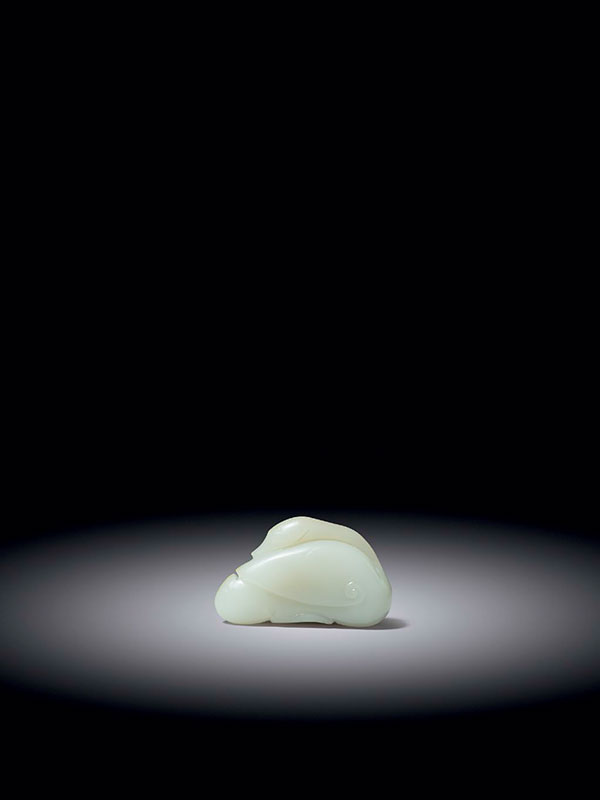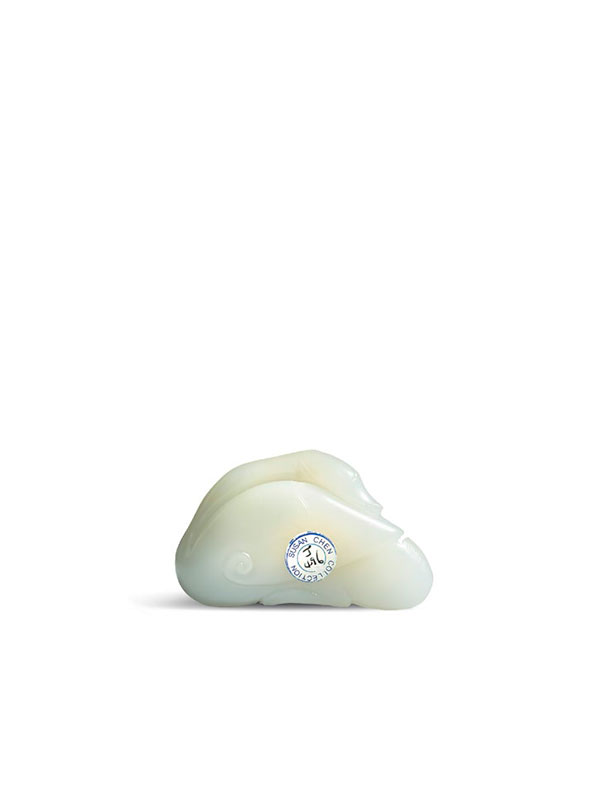White jade goose
A jade carving in the form of a goose. The bird turns its head backwards and rests it on its back, showing a dynamic movement. The head is carved in detail with a pointed beak and round eyes. The body is carved in low relief with a simplistic design overall and large wings on each side. Its feet are tucked beneath its body. The stone is perforated with a hole on its back through to the base and is of an even white colour.
This delicately carved white jade goose is intriguing for its motif and for its simplistic and elegant design. The goose was used in China to identify fourth-rank civil officials from 1528 until 1911. Geese were considered a suitable gift for military leaders since many of their behavioural characteristics (such as the use of sentinels and flight formation) were not dissimilar to those of the military.[1] The drill hole indicates that it was made for wearing as a pendant; examples of such pendants exist earlier in the Song and Yuan dynasties. A slightly smaller Song dynasty (c. 12th -13th centuries) jade goose in similar crouching posture is in the collection of the National Palace Museum, Taipei.[2] A small Yuan dynasty (1279 – 1368) jade goose, excavated from the Fahua Pagoda at Jiading, Shanghai, is in the collection of the Shanghai Commission for Preservation of Ancient Monuments.[3] A Qing dynasty white jade goose with some russet inclusions, slightly smaller in size but closely comparable in shape and posture, is in the collection of the National Palace Museum, Taipei.[4] The latter jade goose is stored in a Qing Court imperial ‘treasure box’, together with other miniature objects.[5] A slightly larger Qing dynasty celadon jade goose, comparable in the crouching posture, was also in the Qing Court collection and is now in the collection of the Palace Museum, Beijing.[6]
Provenance: The Feng Wen Tang Collection of Susan Chen, no. J496 (with label)
Private collection, UK
- Welch, P. B. Chinese Art – A Guide to Motifs and Visual Imagery, Tuttle Publishing, Singapore, 2012, p. 75
- The National Palace Museum, Taipei online collection archive, no. 故玉 8811
- Gu, Fang ed. Complete Collection of Unearthed Jades in China- vol. 7 Jiangsu & Shanghai, Ke xue chu ban she, 2005, Beijing, p. 209
- The National Palace Museum, Taipei online collection archive, no. 故玉5607
- The imperial treasure box is in the collection of The National Palace Museum, Taipei, no. 故雜 1284
- The Complete Collection of Treasures of the Palace Museum- Vol.42 Jadeware (III), Shangwu yinshu guan, Hong Kong, 1995, no. 80, p. 100
白玉雕臥鵝
清 十八世紀
長:6.9 公分
白色籽玉,略呈三角形,質地瑩潤,圓雕成一隻回首貼頸埋羽的雁鵝。鵝頸舒展服貼於背,尖啄收
束,雙目圓潤,軀體肥碩,雙翼緊斂,羽翼根部陰刻出渦狀旋紋,雙爪貼腹隱起。背腹貫有一天地
孔,可繫帶配掛。整體刻飾精練簡約,配合無瑕白玉,更顯高貴雅緻。雁鵝因擇偶後便終身相伴,中
國傳統婚嫁習俗中,便常用一對鵝作為聘禮,象徵夫妻和諧,忠貞不渝。明清官服制度,則以雲雁作
為四品文官代表。小型玉圓雕成回首鵝並以為配飾,自古即深受喜愛,如臺北故宮博物院藏一件宋代
青白玉回首鵝,造型簡約樸拙。上海市嘉定區法華塔元代地宮則出土一件元代白玉鵝配飾,現藏於上
海市文物管理委員會。清代回首鵝玉雕,可見於清宮舊藏:如臺北故宮博物院現藏一件,玉質白中泛
黃,貯在院藏「清 竹絲纏枝番蓮圓盒多寶格」中。北京故宮博物院則有一件青玉回首鵝,然羽翼刻劃
細膩,氣質迥然不同。
來源:香港奉文堂陳淑貞女士舊藏,編號J496 (底有標籤)。英國私人收藏。


